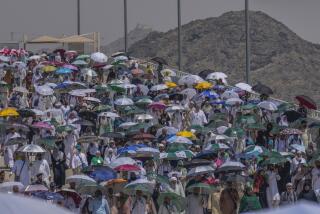At Baghdad Hospital, Bodies of Victims Kept Arriving
- Share via
BAGHDAD — The young woman, wreathed in black, sat on the tile floor and stared straight ahead -- her back against the wall, her knees tucked under her chin. Around her, the hallway of Baghdad’s Karkh Hospital throbbed with sounds of chaos. But the woman remained mute, still and oblivious.
Few could initially comprehend the numbing scope of Wednesday’s bridge disaster in Iraq in which more than 800 Shiite Muslim worshipers were trampled or drowned on one of the most important days of the Shiite year.
Initial news reports of 250 dead seemed impossible, unless there had been a major insurgent attack. The reality turned out to be far worse.
Doctors at Baghdad’s Medical City hospital complex had just a few minutes’ warning before the arrival of what would become an hours-long stream of corpses. And there was little that they could do.
Unlike with a bombing or mortar attack, which Baghdad emergency room crews now have years of experience with, there were few critically injured victims requiring immediate care.
There was no blood, and no patients needing life-saving surgery -- just broken bones, concussions and corpses. Inside the main hospital building, triple rows of bodies wound through corridors. Several doctors and nurses stood helplessly by as mourners moved from body to body; one nurse sitting behind a table of largely unnecessary first aid supplies wept silently.
“Everyone who arrived was either stable or dead,” one doctor said.
The morgues of all four hospitals in Medical City quickly overflowed, forcing truckloads of new victims to lie unattended.
Grieving relatives and covered bodies packed the hallways, parking lot and lawn. The dead lay under the blazing August sun until several refrigeration trucks arrived hours later.
“Who is responsible?” shouted one man outside the hospital. “Who is responsible for this massacre?”
Faced with a shortage of body bags and sheets, doctors covered the corpses with shiny metallic blankets normally used for burn victims.
Mournful sobs and hysterical wailing came from all directions. Everyone in sight seemed to be delivering a body, searching for a body or mourning over a body.
Frantic relatives screamed “my father!” or “my brother!” many of them collapsing in hysterics. Men and women crouched against walls, sobbing.
Others wandered among the clusters of bodies, lifting shrouds and trying to find relatives.
Each truckload set off a mini-stampede of people rushing to see whether a relative was among them.
A bald, white-bearded man stood over the body of a boy, perhaps 12 years old. His mouth twitching wordlessly, the man leaned down over the body, pressing his face against that of the boy. A young man in a gaudy shirt paced in front of the hospital, talking fast on a cellphone.
“I searched everywhere and couldn’t find him,” he said. “There are bodies everywhere. It’s chaos!”
The man was desperately trying to get word on his nephew. After hearing about the incident, relatives had called the nephew’s cellphone.
A stranger answered and said, “The owner of this phone is dead.”
Times staff writer Caesar Ahmed contributed to this report.
More to Read
Sign up for Essential California
The most important California stories and recommendations in your inbox every morning.
You may occasionally receive promotional content from the Los Angeles Times.













